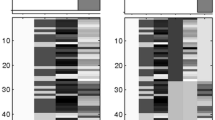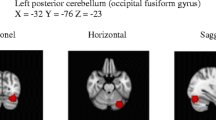Conclusions
Evidence of different syndromes of developmental dyslexia raises the question of the interaction between dyslexic types and patterns of cerebral dominance. Some of the proposed classifications of dyslexia, and most notably the one proposed by Boder (1971), strongly suggest that dyslexic subtypes, that can be identified clinically by reading-spelling patterns, may possess different or opposite cerebral dominance patterns. Thus, research of cerebral dominance in dyslexia (i.e., Orton’s hypothesis) should involve careful selection and classification of subjects. When this is done it can be shown that electrophysiological measures can identify cerebral-dominance abnormalities in at least one subtype of developmental dyslexia.
Similar content being viewed by others
References
Boder, E. 1971. Developmental dyslexia: prevailing diagnostic concepts and a new diagnostic approach.In H. R. Myklebust (ed.).Progress in Learning Disabilities, Vol. 2 New York: Grune and Stratton.
Boder, E. 1973. Developmental dyslexia: a diagnostic approach based on three atypical reading-spelling patterns.Dev. Med. Child Neurol. 15:663–687.
Benton, A.L. 1975. Developmental dyslexia: neurological aspects.In J. Friedlander (ed.).Advances in Neurology, Vol. 7. New York: Raven Press.
Brown, W.S., Marsh, J.T., and Smith, J.C. 1973. Contextual meaning effects on speech-evoked potentials.Behav. Biol. 9:755–761.
Bryden, M.P. 1970. Laterality effects in dichotic listening: relations with handedness and reading ability in children.Neuropsychologia 8:443–450.
Buchsbaum, M. and Wender, P. 1973. Average evoked responses in normal and minimally brain dysfunctioned children treated with amphetamine: A preliminary report.Arch. of Gen. Psychiatry 29:764–770.
Conners, C.K. 1971. Cortical visual evoked response in children with learning disorders.Psychophysiology 7:418–428.
Critchley, M. 1970.The Dyslexic Child. Springfield: Charles C Thomas, Publisher.
Dimond, J.S. and Beaumont, J.G. 1974. (eds.).Hemisphere Function in the Human Brain. London: Elek Science.
Donchin, E., Kutas, M., and McCarthy, G. 1977. Electrocortical indices of hemispheric utilization.In S. Harnard, R.W. Doty, L. Goldstein, J. Jaynes and G. Krauthamer (eds.).Lateralization in the Nervous System. New York: Academic Press.
Doyle, J.C., Ornstein, R., and Galin, D. 1974. Lateral specialization of cognitive mode: EEG frequency analysis.Psychophysiology 11:567–578.
Fried, I., Tanguay, P.E., Boder, E., Doubleday, C., and Greensite, M. 1979. Developmental dyslexia: electrophysiological evidence of clinical subgroups. Submitted for publication.
Friedman, D., Simon, R., Riter, W., and Rapin, I. 1975. Cortical evoked potentials elicited by real speech words and human sounds.Electroencephalography and Clinical Neurophysiology 38:13–19.
Galin, D. and Ornstein. R. 1972. Lateral specialization of cognitive mode: an EEG study.Psychophysiology 9:412–418.
Ingram, D. 1975. Cerebral speech lateralization in young children.Neuropsychologia 13:103–105.
Ingram, T. T. S., Mason, A. W., and Blackburn, I. 1970. A retrospective study of 82 children with learning disability.Dev. Med. Child Neurol. 12:271–281.
Kimura, D. 1961. Cerebral dominance and the perception of verbal stimuli.Can. J. Psychol. 15:166–171.
Kimura, D. 1966. Dual functional asymmetry of the brain in visual perception.Neuropsychologia 4:275–285.
Kinsbourne, M. and Warrington, E.K. 1966. Developmental factors in reading and writing backwardness.In J. Money (ed.).The Disabled Reader: Education of the Dyslexic Child. Baltimore: John Hopkins Press.
Levy-Agrest, J. and Sperry, R.W. 1968. Differential perceptual capacities in major and minor hemispheres.Proc. Nat. Acad. Sci. USA 61:1151.
Marshal, J.C. and Newcombe, F. 1973. Patterns of paralexia: A psycholinguistic approach.Dev. Med. Child Neurol. 2:175–199.
Morgan, A.H., MacDonald, H., and Hilgard, E.R. 1974. EEG alpha: lateral asymmetry related to task and hypnotizability.Psychophysiology 11:275–282.
Myklebust, H.R. 1965.Development and Disorders of Written Language: Picture-Story Language Test. New York: Grune and Stratton.
Olson, M.E. 1973. Laterality differences in tachistoscopic word recognition in normal and delayed readers in elementary school.Neuropsychologia 11:343–350.
Orton, S.T. 1937.Reading, Writing and Speech Problems in Children. New York: W.W. Norton and Company.
Pirozzolo, F.V. 1978.The Neuropsychology of Developmental Reading Disorders. New York: Praeger Publishers.
Preston, M.S., Guthrie, J.T., and Childs, B. 1974. Visual evoked responses (VERs) in normal and disabled readers.Psychophysiology 11:452–457.
Preston, M. S., Guthrie, J. T., Kirsch, I., Gertman, D., and Childs, B. 1977. VERs in normal and disabled adult readers.Psychophysiology 14:8–14.
Sklar, B., Hanley, J., and Simmons, W. W. 1973. A computer analysis of EEG spectral signatures from normal and dyslexic children.IEEE Transactions of Biomedical Engineering, Vol. BME-20:20–26.
Sobotka, K.R. and May, J.G. 1977. Visual evoked potentials and reaction time in normal and dyslexic children.Psychophysiology 14:18–24.
Witelson, S.F. 1977. Developmental dyslexia: Two right hemispheres and none left.Science 195:309–311.
Wood, C.C., Goff, W.R., and Day, R.S. 1971. Auditory evoked potentials during speech perception.Science 173:1248–1251.
Yeni-Komshian, G.H., Isenberg, S., and Goldberg, H. 1975. Cerebral dominance and reading disability: left visual field deficit in poor readers.Neuropsychologia 13:83–94.
Zaidel, E. 1978. Lexical organization in the right hemisphere.In Buser and Rougeul-Buser (eds.).Cerebral Correlates of Conscious Experience INSERM Symposium, No. 5. Elsevier/North-Holland Biomedical Press.
Zangwill, O.L. 1960.Cerebral Dominance and its Relation to Psychological Function. Edinburgh: Oliver and Boyd.
Zurif, E.G. and Carson, G. 1970. Dyslexia in relation to cerebral dominance and temporal analysis.Neuropsychologia 8:351–361.
Author information
Authors and Affiliations
Rights and permissions
About this article
Cite this article
Fried, I. Cerebral dominance and subtypes of developmental dyslexia. Bulletin of the Orton Society 29, 101–112 (1979). https://doi.org/10.1007/BF02653737
Issue Date:
DOI: https://doi.org/10.1007/BF02653737




